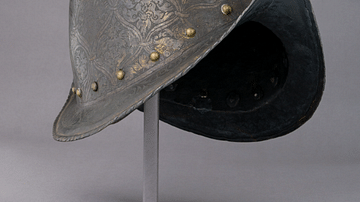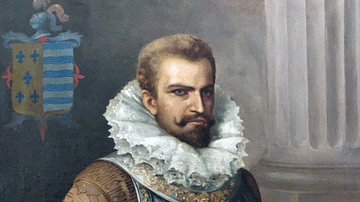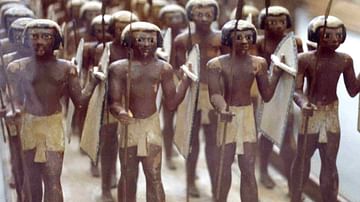The Iberian conquistadors ("conquerors") were the first military men to explore, attack, and conquer territories in the Americas and Asia that would then become a part of the Spanish or Portuguese Empire. Indigenous peoples could not match the conquistadors' weapons of cannons, swords, crossbows, and lances or, most devastating of all, their armoured cavalry.
The superiority of conquistador weapons was combined with disciplined tactics and significant aid from indigenous allies, which meant they lived up to their name time and time again from Mexico to Peru, India to the Philippines. Once the conquistadors had swept through a territory like a plague, the colonization process proper was undertaken by settlers and officials sent by the Spanish and Portuguese crowns to 'pacify' a region and begin the systematic and prolonged exploitation of people and resources.
Vanguard of the Empire
The conquistadors of the 15th and 16th centuries were the vanguards of the Portuguese and Spanish empires as they expanded outside of Europe. Men who had gained military experience and a taste of victory in such conflicts as the Reconquista and Italian wars, the conquistadors had dubious morals and were motivated above all by dreams of personal riches. Incidental for most were the goals of exploration, trade, colonization, and evangelism that preoccupied the Spanish and Portuguese authorities. Some conquistadors, notably the leaders, may have entertained more lofty goals of exploration and 'civilizing' the peoples they encountered, but the rank and file were utterly ruthless invaders who would stop at nothing, not even at murdering their fellow Europeans, in order to satisfy their thirst for wealth and, above all, gold. The conquistadors were such a liability that European monarchs were ever eager to replace them with more controllable colonial officials as soon as possible in any new territory.
The major obstacle that stood between a conquistador and the wealth with which they could retire back in Spain was the indigenous peoples. Naturally, local tribes, as soon as they realised these visitors from another world were invaders set on conquest, put up the best resistance they could to hold on to their land, resources, and even their very cultural survival. Unfortunately for the indigenous peoples of the Americas and elsewhere, although many were greatly accomplished at warfare, they were not just centuries but eons behind the Europeans in terms of weaponry. Such was the superiority of the weapons of the conquistadors, the Europeans had no qualms about taking on an army far larger than their own small force, and their countless victories made them seem invincible.
The Conquistador Arsenal
A force of conquistadors could rely on the following impressive array of weaponry:
- cannons
- arquebuses
- crossbows
- swords
- halberds
- pikes
- lances
- daggers
- attack dogs
Cannons came in various sizes from handheld versions to the larger wheeled variety suitable for attacking defensive fortifications. There were culverins, falconets, and lombards, to name but a few of the myriad cannon types in use in the Early Modern Period. Due to their cost and weight and the paucity of gunpowder available, very few cannons were used in warfare in the Americas and colonies compared to battles back in Europe. The force of conquistadors led by Hernán Cortés (1485-1547) which conquered the Aztec civilization in Mexico from 1519, for example, carried only around 18 cannons of all types. The lack of precious horses and local beasts of burden meant human porters often had to be roped in to drag the cannons from one battle to another. Still, a handful of cannons loaded with grapeshot and random metal pieces could cause tremendous physical and psychological damage to an enemy entirely unused to such terrors. Smoke, noise, and, of course, the terrible and never-before-seen wounds they inflicted meant cannons were worth the trouble it took to get them into the action.
Arquebuses were unwieldy weapons that required a constant lit match and a stand for their long barrels (39 to 60 inches or 1 to 1.5 m). The slow loading time - one shot every 90 seconds - was another negative factor for the effective use of firearms of this kind. Used much less than on the more ordered European battlefields of the period, the arquebus was most useful as a shock weapon to instil fear into the enemy rather than actually create injuries. They could be used effectively, though, in sieges for both defence and attack where protective screens or battlements allowed the firer to reload in safety.
Another effective weapon in Europe that was much less so outside that continent was the crossbow. Crossbows came in all sizes and materials such as steel, wood, bone, and cane. They could fire a bolt with enough power to pierce metal armour and fire over a distance of up to 305 m (1,000 ft). The problem for the conquistadors was that their enemy had no such armour, and the weapon's precision in killing a singled-out opponent was rather less useful when dealing with an enemy of thousands attacking one on a very wide front. Like the arquebus, the crossbow's cumbersome mechanism, where the string was pulled back using a ratchet or key, and the distinct vulnerability of degradable parts to the local climate conditions, led to serious reliability problems. The slow loading time of crossbows – one bolt fired per minute – meant they, too, were best used in sieges. Another serious limitation of projectile weapons like cannons, arquebuses, and crossbows was the logistical problem of keeping them supplied with ammunition and gunpowder.
Rather than projectile weapons, it was the close-quarter hand-to-hand weapons which gave the conquistadors a real advantage. Lances were typically 3-4 meters (9-12 ft) in length, and their long metal points were highly effective at piercing native armour.
Swords came in various styles and lengths, but blades in this period were generally long (around I m or 40 in), thin, and double-edged. The blade, made, for example, from Toledo steel, ended in a point, and so the weapon could be used to both stab and slash in two directions. Very often while an enemy warrior was engaged in slashing down on a conquistador, the latter could make a stabbing movement and dispatch his foe with a fatal chest wound. Swords could have a single or two-handed handle, while guards were a simple length of iron. A common European type of the period had an S-shaped bar with one end bent back to act as a hand guard and the other end bent forwards so that one could entangle an opponent's blade or weapon and wrest it from their hand. The lightweight and cheap-to-produce steel falchion was popular with conquistadors, its slightly curved blade showing an obvious influence from weapons used by the Moors in Spain. The Europeans knew their swords gave them a vital advantage, and for this reason, no native American was allowed to possess one in Spanish-held territory.
Finally, a never-before-seen weapon in American warfare was the ferocious attack dogs employed by the conquistadors. These were Irish wolfhounds, mastiffs, and deerhounds, brought along to hunt meat and attack enemy warriors in packs. A deerhound has a height of up to 80 cm (30 in) and weighs around 40 kg (90 lbs), a monstrous sight for people like the Aztecs, who were used only to chihuahuas. Dogs were also used by some conquistadors as a slow method of execution for captives.
Armour & Cavalry
Two vital additions to the conquistador advantage when fighting indigenous peoples were their armour and their horses. Cavalry, when used on good ground and with a disciplined formation, proved all but invincible in the Americas, for example. The conquistador and chronicler Pedro de Cieza de León aptly described the horse as the Spaniards' fortaleza or "fortress" (Sheppard, 44). However, transporting horses across oceans was not an easy feat of logistics. Horses were also terribly expensive, which explains why a force such as that led by Francisco Pizarro (c. 1478-1541), which attacked the Inca civilization in Peru in 1532, initially contained only 62 horses.
Cavalry riders often wore three-quarter armour with, for ease of movement and speed, leather boots. They typically wore a cuirass, upper leg guards, and gauntlets of metal. As the conquest of the Americas went on, armour tended to become lighter since it need not protect against bullets or bolts. Humid climate conditions, in any case, played havoc with metal armour, even if the Spanish attempted to counter this by painting pieces black. Many conquistadors were not averse to adopting local types of armour like quilted jackets of cotton or maguey fibres which had been soaked in a saltwater solution to toughen them sufficiently to withstand arrows.
Cavalry riders wore helmets but usually without a face guard. The horse might be protected with steel plates down the neck and across the front of the head. Leather saddles had steel plate additions to offer extra protection for the upper thighs and groin. Thus protected, a rider could charge the enemy using the horse itself as a battering ram and then take full advantage of their greater height by slashing down upon their foe with a sword or jabbing with a lance. They might carry a buckler shield, a small circle of steel used to parry blows from an attacker. Hardened leather shields were also used, as these were lighter and sufficient to withstand the blows made by the weapons of their non-European enemies.
A horseman had much greater speed and manoeuvrability than an infantry soldier. The chronicler Cieza de León described the effective combination of crossbows and cavalry in Mexico:
…setting up two companies with crossbows, bucklers, and pikes, and another two with horses, he [the commander Rojas] approached the largest squadron of the Indians from two sides so that the crossbows could do it much harm…he [then] attacked on two sides with the horses in a closed and tight thong. Trampling and killing with the lances, they opened up the squadron…the Indians were defeated and dispersed. (Sheppard, 45)
Infantry, the bulk of any conquistador army, wore more basic steel helmets like the sallet, cabacet, morion, and burgonet, which have a declining rim. Their torso might be protected by a cuirass of metal plates attached to a linen or leather backing, or a mail shirt. The neck could be protected by wearing a high metal collar or gorget that rose to protect the lower part of the face. Over time, conquistador infantry adopted lighter local armour since it was effective against local weapons.
The Enemy's Response
Indigenous peoples were equipped with their own array of weapons, but these were largely slashing weapons using blades made from bronze, copper, or such sharp but easily shattered materials like obsidian. Other commonly used weapons were the bow, sling, javelin, sword-club, spiked mace, battle-axe, and spear. Blades and points were made from either obsidian or fire-hardened wood, but these could not pierce the metal armour of the Europeans. Only with a direct hit to an unprotected area like the face could a conquistador be put in any serious trouble. It is for this reason that chroniclers frequently report injuries such as lost teeth, noses, and eyes amongst the conquistadors but very rarely deaths. The armour of the indigenous Americans has been mentioned already, and this was supplemented with a small shield made of wood, cane, or leather. Again, these were no match for gunpowder weapons or the stabbing techniques of European swordsmen.
The conquistadors were not, of course, invincible, even if they may have seemed so. In more open battles, the European cavalry reigned supreme, and so indigenous armies eventually avoided these types of confrontation. The Maya, in particular, were adept at guerilla-like warfare, using ambushes and night attacks to great effect. At the siege of Cusco in 1536-7, an Inca army put up a fierce and prolonged resistance against the conquistadors. There were, too, plenty of reversals when local warriors used their knowledge of topography to good effect or when the conquistadors became overconfident or isolated into smaller groups.
Native peoples soon adapted to the new threats of unfamiliar weaponry and cavalry. During the fall of Tenochtitlan in 1521, Aztec warriors made sure they avoided the arcs of fire of gunpowder weapons. They dug spiked pits to entrap horses and reused captured swords, attaching them to long poles. Native Americans often had their own unique weapons that the Europeans were unfamiliar with and so paid dearly in lives before they educated themselves as to their threat. The Incas developed the bolus (several balls connected with leather thongs) specifically to bring down horses. The people of Venezuela used long pikes against cavalry with great effect. The natives on the coast of Colombia used poisoned arrows to successfully defend their territory. There are other cases of defiance, but the general story was one of European soldiers relentlessly winning the key battles.
There were other threats to the conquistadors besides enemy weapons. Tropical diseases, venomous snakes, starvation, and fellow conquistadors very often brought about their demise. History tells its own story, though. As waves of new settlers and administrators moved into territories first grabbed by the conquistadors, the Spanish and Portuguese empires eventually stretched around the globe, and this was made possible by combining a total war strategy with the use of local allies. An inestimable aid to imperial ambitions was the almost total breakdown in social and political structures in these colonized areas due to the spread of European diseases, an invisible enemy far deadlier than any of the weapons carried by the conquistadors.










